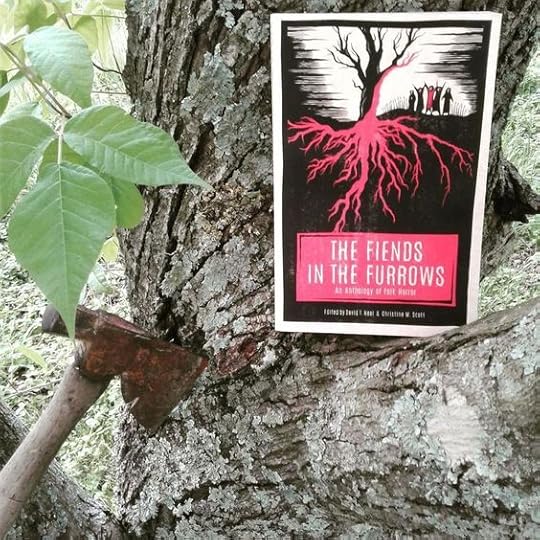Book Review: The Fiends in the Furrows: An Anthology of Folk Horror
 The Fiends in the Furrows: An Anthology of Folk Horror by David T. Neal
The Fiends in the Furrows: An Anthology of Folk Horror by David T. NealMy rating: 5 of 5 stars
Folk Horror is a favorite subgenre of mine, and I wasn't disappointed by this first volume in Nosetouch Press's anthology series. Anthologies are tough, and there is almost always a range of opinions about which stories land and which might not for any given reader. However, there is a lot to love in each of these stories. My three favorites include "Sire of the Hatchet," "The First Order of Whaleyville's Divine Basilisk Handlers," and "The Fruit".
"Sire of the Hatchet" by Coy Hall
This story really sets the table for the whole anthology. Hall's prose is exceptional, the characters are fully drawn (which is no small task in short stories), and the classic Folk Horror mood has the requisite contrast between the mysterious and the threatening. Witchcraft, executioners, Puritanical ideologues, and something old stirring in the forests on the outskirts of town. One of the best in the anthology.
"Back Along the Old Tracks" by Sam Hicks
This is one is very well written and one of two stories that follows the core motif of a metropolitan visitor getting a peek behind the rural curtain. There are also echoes of Lovecraft here in two ways. First, the outsider runs afoul of a family whose consanguinity and cursed condition has made them feared throughout the village. And second, Hicks hints, teases, implies, and suggests much, and allows our imagination to expand into the spaces he doesn't fill explicitly.

"The Fruit" by Lindsay King-Miller
This one is eerie, seductive, and dangerous. The world building is both lush and menacing. King-Miller's mastery of language and "voicey" narration makes it my favorite story in the whole anthology. I could go on and on about this one, but it really is a perfect slice of Folk Horror.
"The Jaws of Ouroboros" by Steve Toase
Initially I had mixed feelings about this story. Compared to the others, it is not straightforward Folk Horror, but operates more as a gritty noir story. However, I think it might represent a completely new subgenre, almost a postmodern Folk Horror. Traditionally, much of Folk Horror deals with the modern world's intrusion into the rural spaces where old ways clash with modernity. This one turns that on its head, and instead it is as if the story begins sometime after the rural elements have played out and the pastoral darkness has begun leaking out into the wider world. As a result, the insatiable hunger of ancient standing stones has provided a lucrative commodity for the criminal underworld, which is all too happy to sell the horrors of the countryside to city folk for the right price.
"The First Order of Whaleyville's Divine Basilisk Handlers" by Eric J. Guignard
I live in a state that does still have a few churches where snake handling is practiced, though technically illegal, so this story was a hoot. While there was a lot of rather morbid events, the story is probably one of two in the anthology that could maybe be considered joyful, probably because of the youth of the protagonist. It's wonderfully written, and other than "Back Along the Old Tracks" is the only one that really delves into the sense of community that small, rustic towns often have. Barn dances, get togethers, neighbors-as-family...but also town rivalries, gossips, religious hypocrites, and neighborly jealousies. This one was one of my favorites.
"Pumpkin, Dear" by Romey Petite
While the plot is straightforward, there's a lot going on in this story. There's an ebb and flow between when the narration is true and when it's unreliable. Adultery (maybe), mental illness (maybe), possession (maybe), body horror, homunculi alchemy, murder, resurrection, reincarnation, misogyny, feminism, prudishness, sexual liberation...yeah, lots going on. On the one hand, it has a dream-like, fairy tale quality; and on the other, there's a more modern and voyeuristic element where we watch the slow disintegration of a marriage. Of the list, this one feels like it has the most to offer if re-read a few times.
"The Way of the Mother" by Stephanie Ellis
This story made me mad. I mean that as a compliment. Occasionally good stories do that. I personally hate it when Puritanical busybodies have a measure of authority, and that plays out in force here. It features a closed society that has walled itself off from the modern world, and requires its residents to remain perpetually stuck in a different era or suffer deadly consequences. The absolutist, authoritarian qualities of the antagonist (who, admittingly, others might not consider an antagonist) really hit all of my buttons. I absolutely despised him. I literally stopped reading this anthology for a few days after this story because I hated him so much. It takes a lot of talent as an author to make a character evoke that much emotion. The writing is truly wonderful, and the imagery is maybe the best in the anthology.
"Leave the Night" by Zachary Von Houser
This is the second of two stories that follow an outsider visiting the countryside. I had recently read "The Legend of Sleepy Hollow" for the first time, and this story's first half reminded me of Irving's tale. Von Houser (or his protagonist) had a love for or keen eye for nature. The descriptions of the landscapes were beautifully written. It would be difficult not to cite The Wicker Man here, as it felt like this story was playing with similar thematic pieces. My only complaint was about an imagery shift that occurs. A lot of work goes into establishing a bird-like mythology throughout the first 95% of the story, but at the last possible moment the imagery switches to a totally different set of animal symbols. It feels like there's a reason for it, but not knowing it created a lack of resolution for me.
"Revival" by S.T. Gibson
Much like "The First Order of Whaleyville's Divine Basilisk Handlers", this story has snake handling, a young protagonist, and a generally joyful disposition. "Young" is probably an understatement, as this is the only story where the main character is a child, and she's one of the best characters in the anthology. There's some really interesting internecine religious imagery here, juxtaposing rural, Pentecostal-style beliefs with traditional Catholic theology. That collision is often messy in real life, and has created a delicate fault line in the girl's family. There's revenge, religious ecstasy, and family dysfunction. It's a great send off for this volume.
Folk Horror is experiencing a boom right now, and this anthology is a great addition to the subgenre. I highly recommend it.
My Goodreads Reviews | Amazon | Twitter | Instagram | Pinterest | Linktree
Published on May 12, 2022 17:47
•
Tags:
book-review
No comments have been added yet.



